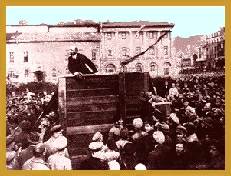|
PinkMonkey Online Study Guide-World History
12.1 Causes of the Russian Revolution
Various factors and forces led to the Russian Revolution
of 1917.
The economic factors were the main factors
contributing to the Revolution, as they resulted in poverty, misery
and exploitation of the masses by the nobility.
Russia was mainly a highly backward agricultural
country before the revolution. The royal family, the nobility
and the clergy owned most of the agricultural land. Only between
three and ten acres of land was owned by 70% of the peasants. Many
of them had to earn their livelihood only 2˝ acres land or even
less. In addition they had to use primitive tools, implements and
methods of cultivation, which were not very productive.
Further, the poor peasants became poorer as they
had to pay huge sums of rent and tributes to their landlords every
year. This created great discontent among the farmers who
were ready to revolt against the Czarist government, in order to
end this economic and social system.
In the industrial sphere too, Russia was
backward and depended only on foreign capital. The workers
and laborers had to endure miserable working conditions. They received
extremely low wages and worked for 12 to 14 hours a day. They had
to go without any medical relief in case of an accident while on
duty. They did not even have a weekly holiday. It was considered
a crime to form trade unions.
Moreover, the government did not attempt to
improve these conditions. Instead, the Russian villages and
cities suffered from poverty, dirt and disease caused by the exorbitant
land revenue and the unbearably high taxes and levies.
There was an imbalance in the social structure,
owing to the above economic factors. As a result 70% of the
Russian population was illiterate. The social structure of
Russia was completely devoid of education, medical relief and public
health. The masses being poor, hungry, diseased and ignorant were
highly addicted to vodka, a very powerful intoxicant. Above all
the system of flogging that prevailed in the whole of Russia made
Russian social life, highly miserable, inhuman and wretched.
Political factors also formed an important
cause of the Russian Revolution of 1917. The masses had no legal
means of improving the social structure. A strike was considered
to be a mutiny. The people had no press to ventilate their grievances.
The Czarist government was ruthless,
absolute and repressive. On January 15, 1905, a peaceful demonstration
led by Father Gapon at St. Petersburg was fired upon by the Czarist
troops. The Duma (parliament) had limited powers. Franchise was
not given to women, laborers and the common people.
The growing discontent among the masses manifested
itself in all aspects of national life. The working class became
highly receptive to Marxist ideas infiltrating into Russia. In
1893, the Social Democratic Party was founded and in 1903,
this party was split into two; the Bolsheviks led by Nikolai
Lenin and the Mensheviks led by Martov. While the former
was revolutionary and supported by Stalin, the latter
was evolutionary and was supported by Trotsky.

Exhibit 12.1
Russian leader Lenin at a communist rally
|